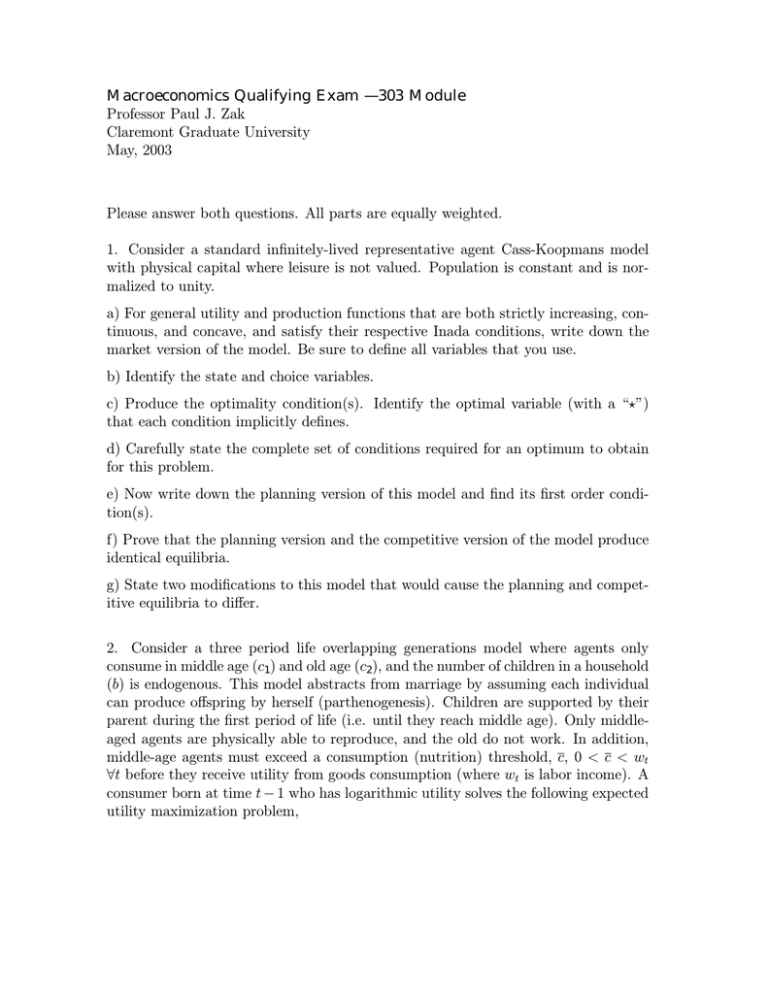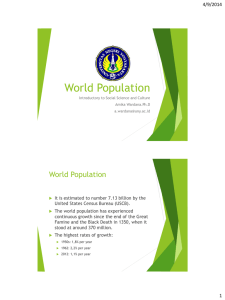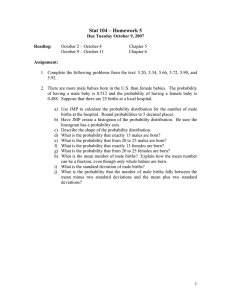Macroeconomics Qualifying Exam — 303 Module Professor Paul J. Zak May, 2003
advertisement

Macroeconomics Qualifying Exam — 303 Module Professor Paul J. Zak Claremont Graduate University May, 2003 Please answer both questions. All parts are equally weighted. 1. Consider a standard infinitely-lived representative agent Cass-Koopmans model with physical capital where leisure is not valued. Population is constant and is normalized to unity. a) For general utility and production functions that are both strictly increasing, continuous, and concave, and satisfy their respective Inada conditions, write down the market version of the model. Be sure to define all variables that you use. b) Identify the state and choice variables. c) Produce the optimality condition(s). Identify the optimal variable (with a “?”) that each condition implicitly defines. d) Carefully state the complete set of conditions required for an optimum to obtain for this problem. e) Now write down the planning version of this model and find its first order condition(s). f) Prove that the planning version and the competitive version of the model produce identical equilibria. g) State two modifications to this model that would cause the planning and competitive equilibria to differ. 2. Consider a three period life overlapping generations model where agents only consume in middle age (c1 ) and old age (c2 ), and the number of children in a household (b) is endogenous. This model abstracts from marriage by assuming each individual can produce offspring by herself (parthenogenesis). Children are supported by their parent during the first period of life (i.e. until they reach middle age). Only middleaged agents are physically able to reproduce, and the old do not work. In addition, middle-age agents must exceed a consumption (nutrition) threshold, c, 0 < c < wt ∀t before they receive utility from goods consumption (where wt is labor income). A consumer born at time t − 1 who has logarithmic utility solves the following expected utility maximization problem, M axc1,t ,c2,t+1 ,bt (1 − β) ln(c1,t − c) + β ln(c2,t+1 ) + γ ln(bt ) s.t. c1,t = wt − ηwt2 bt − st c2,t+1 = Rt+1 st . In this model, s is savings, R is the yield on savings (1 plus the interest rate less depreciation), the cost of children is a quadratic function of labor income, ηwt2 , for some positive constant η, and β ∈ (0, 1), γ > 0. Because of the demographic and labor market structures, the size of the workforce is last period’s total births, i.e. Nt+1 = bt Nt , where Nt is the number of middle-aged agents at time t. a) Solve the first order conditions for the optimal response functions for savings, s?t and births, b?t (assume that the desired number of children is a continuous variable in the model). b) Determine the effect of the consumption threshold c on optimal savings and births. Prove or disprove: births are decreasing in labor income wt . c) Analyze the dynamics of this model...Carefully. First, solve for wt and Rt+1 using the production function F (Kt , Nt ) = Ktα Ntα for α ∈ (0, 1). Next, construct the aggregate laws of motion for physical capital and the labor force. Then, using these, write the law of motion in per middle-age terms using only the state variable(s) and constants. d) Prove or disprove: An increase in the consumption threshold c decreases the accumulation of per middle-age physical capital. Briefly explain why the result you find obtains. e) Completely characterize the equilibrium dynamics in this model graphically in kt , kt+1 space. Include a 45 degree line and arrows of motion showing how the economy evolves. State the stability property of each stationary equilibrium. f) We now modify the model so that not all children survive the birth process. Assume that childbirth is costless, and parents must therefore only support children who live. Further, once a child is born, she lives to old age with certainty. So, the only change in the model is that the utility flow from children is in expectation. Solve for the optimal number of births in this model and prove that the expected deaths of some children causes a greater number of desired births. g) Discuss briefly the results of (f) in terms of the effects of infant mortality in developing countries. Modify the model of part (f) to show the effect of the government of this country putting a lump sum tax τ > 0 on middle-age agents to improve the provision of clean water which reduces infant mortality.






